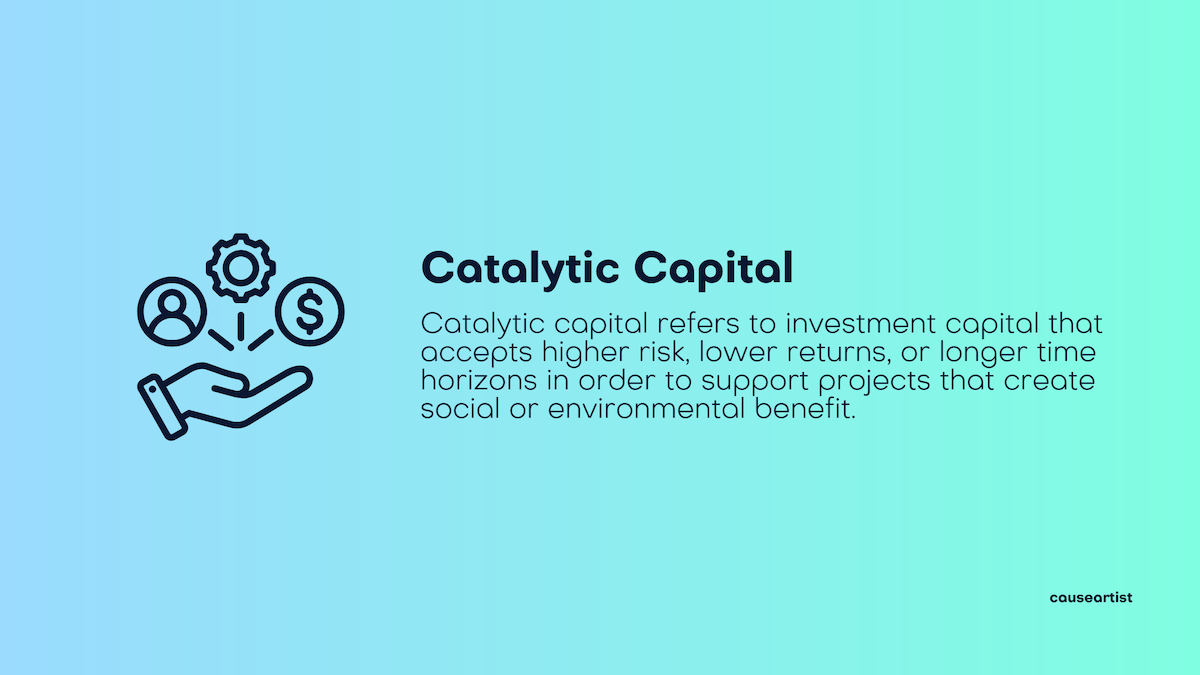Catalytic capital refers to investment capital that accepts higher risk, lower returns, or longer time horizons in order to support projects that create social or environmental benefit.
It is usually provided by foundations, family offices, development finance institutions, and impact focused investors who are willing to lead early when others will not.
Catalytic capital is not charity.
It is investment capital with a clear purpose.
It reaches entrepreneurs and communities that do not have fair access to markets and it gives them a realistic path to build.
Why Catalytic Capital Is Needed
Many impact ventures face challenges such as:
• Thin or early revenue
• High operating risk due to serving low income communities
• Long timelines to build trust in overlooked regions
• New business models that take time for investors to understand
Traditional investors often see these factors as red flags.
Catalytic capital sees them as expected features of solving tough problems.
By taking the early risk, catalytic investors help prove the model, which then encourages more commercial investors to step in later.
This makes catalytic capital a bridge between early promise and long term scale.
How Catalytic Capital Works in Practice
Catalytic capital can take several forms.
Each one supports entrepreneurs in a different way.
1. Concessional Debt
Loans with below market rates, longer maturities, or softer collateral requirements. This gives early stage ventures breathing room to develop real stability before needing to meet strict repayment schedules.
2. First Loss Capital
Investors agree to absorb losses first if a project underperforms. This protects later investors and brings them into deals they would otherwise reject.
3. Guarantees
A catalytic investor guarantees a portion of a loan or fund. Lenders feel safer and extend credit to organizations that have historically been locked out of the financial system.
4. Flexible Equity
Equity that accepts lower return expectations or allows longer time for value creation. This is helpful when companies serve communities where growth is steady but not explosive.
5. Patient Capital
Capital that is willing to wait longer before expecting returns. This is common when working in sectors like climate resilience, smallholder agriculture, education, or community development.

Who Uses Catalytic Capital
Catalytic capital is most often used by:
• Social enterprises in emerging markets
• Climate and clean energy ventures
• Funds serving low income communities
• Early stage impact founders who need first checks
• Nonprofits shifting into earned revenue models
• Cooperatives and community owned enterprises
It supports work that needs long term commitment rather than short term financial pressure.
Real World Examples of Catalytic Capital
1. The Rockefeller Foundation
A long time leader in the field, the foundation uses program related investments to support early stage health, energy, and economic mobility projects that lack commercial backing.
2. MacArthur Foundation’s Catalytic Capital Consortium
This global effort brings together foundations and investors to demonstrate how patient and flexible finance can unlock private capital for underserved communities.
3. Acumen
Acumen uses patient capital to support early stage social enterprises that serve low income customers across Africa, South Asia, and Latin America.
4. Development Finance Institutions
Institutions such as IFC and the US International Development Finance Corporation frequently use guarantees, first loss positions, and concessional debt to reduce risk for private investors.
How Catalytic Capital Unlocks Private Investment
Catalytic capital attracts commercial investors in several ways:
• It absorbs risk in the early years.
• It builds market data for untested models.
• It supports management teams until they are ready for scale.
• It shows that social enterprises can become sustainable businesses.
Once early risk is reduced, mainstream investors feel more comfortable entering the deal. This is how catalytic capital multiplies its effect. One dollar of catalytic capital can unlock several dollars of commercial capital.
What Catalytic Capital Is Not
To keep expectations realistic, it is important to understand what catalytic capital does not do.
• It does not replace commercial investment in the long term.
• It does not aim for maximum financial return.
• It does not solve every market failure.
• It should not be used to subsidize irresponsible business models.
Catalytic capital should be used with discipline. It supports ventures that have strong mission intent, credible management, and the potential for long term independence.
When to Use Catalytic Capital
Catalytic capital is most useful when:
• The social or environmental need is clear.
• The venture has shown early proof of concept.
• Commercial investors are interested but hesitant.
• Communities have been historically underinvested in.
• The project cannot move forward without some early risk taking.
If the goal is to reach people who are often overlooked, catalytic capital is one of the strongest tools available.








